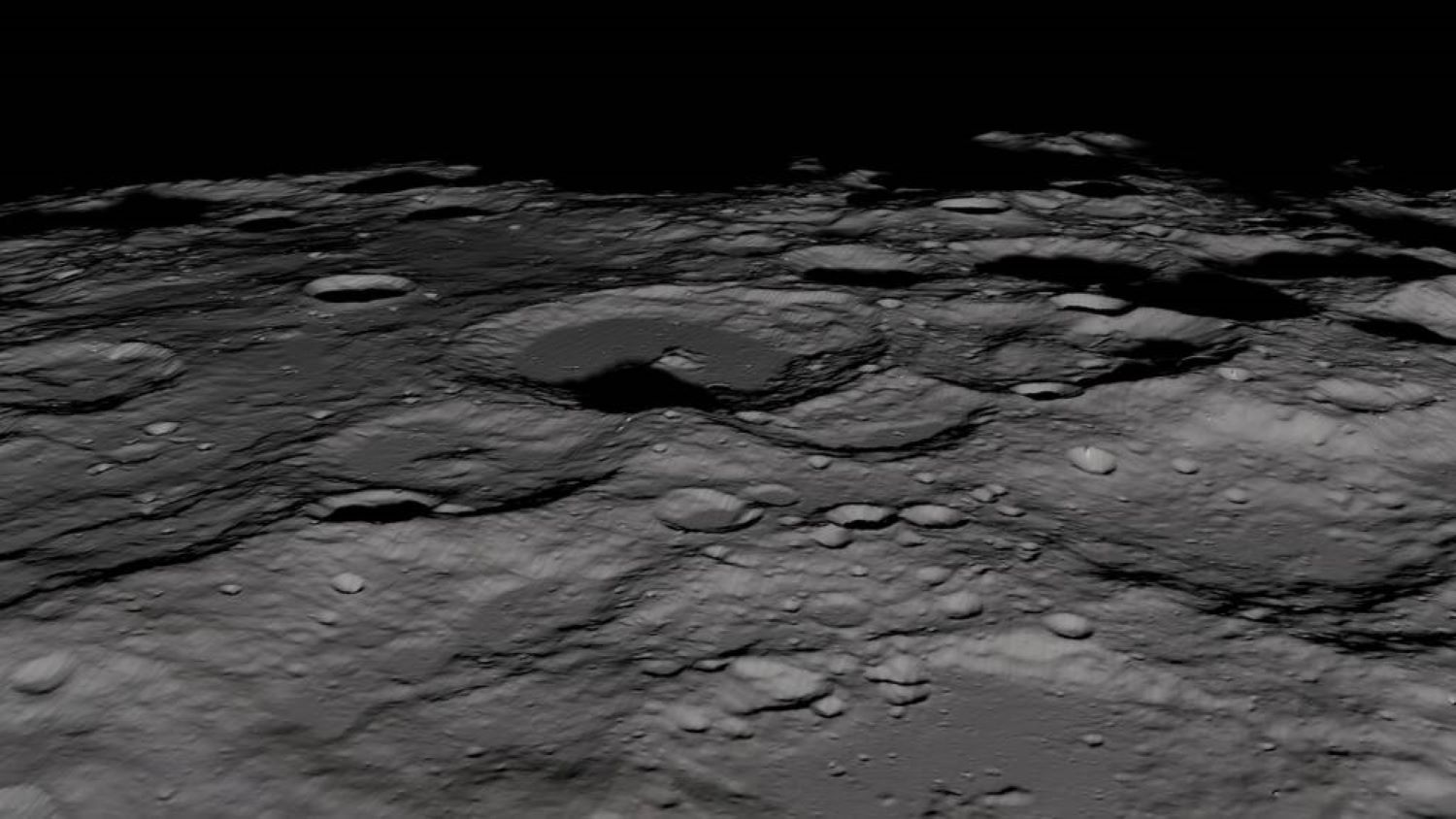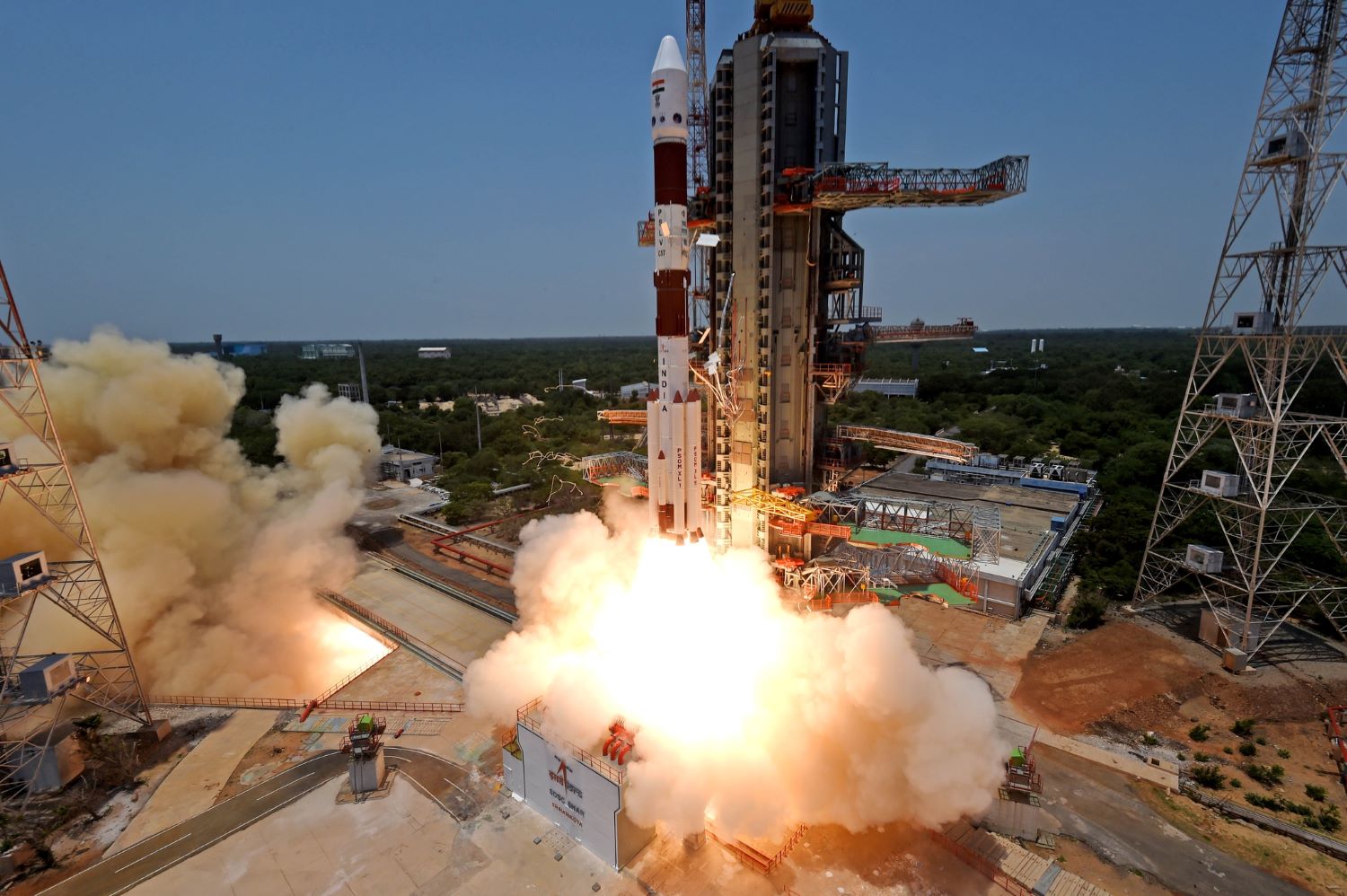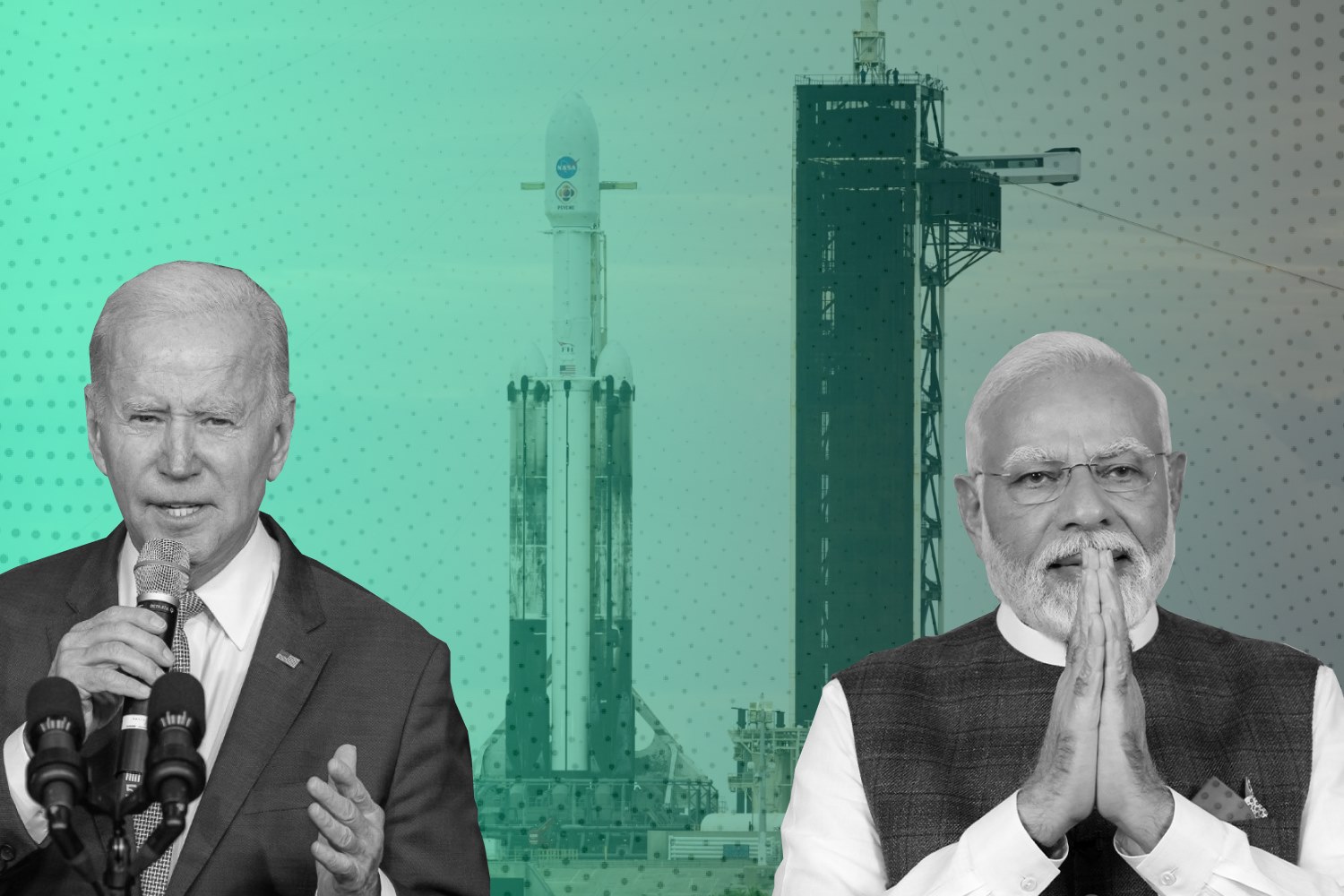Ultimate Resources Chase – The Lunar Race Heats Up
The Moon’s bountiful water resource, while not widely known, was only definitively confirmed in 2009. This revelation holds immense significance, as it unveils water’s remarkable versatility as a space resource.
Water can undergo conversion into life-sustaining oxygen, serve as a potent source of hydrogen fuel, and even quench the thirst of future lunar explorers. In essence, the revelation of water on the Moon could usher in the possibility of establishing a lunar base and revolutionize our approach to lunar exploration.
This is the driving force behind the heating lunar race in recent years, inspiring nations to showcase their technology to touch down at the South Pole of the Moon. As the battle is getting crowded, let’s break down this surging race.
The Prime Real Estate of the Solar System
In the past year, from 2022 to now, there’s been a noteworthy shift in the landscape of lunar missions. Initially, the forecast was for approximately 250 lunar missions over the next decade, which was already quite significant. However, in the current year, the projected figure has surged to a staggering 400 missions set for 2023.
The lunar exploration journey has witnessed over 140 missions since the 1950s, encompassing historic landings, uncontrolled crashes, and extensive orbits around this celestial body.
Back in September 1959, the USSR achieved a significant milestone when its unmanned Luna 2 spacecraft became the first man-made object to successfully touch down on the Moon. Fast forward a decade to July 1969, and America’s Apollo 11 mission marked another momentous achievement as it carried humans to the lunar surface for the very first time.
This period was defined by the intense “space race” between the two Cold War rivals, which led to the majority of their Moon landings occurring during the 1960s and 1970s. Following this flurry of lunar activity, humanity took a hiatus from Moon landings that lasted for 37 years until China accomplished its inaugural lunar touchdown in 2013.
The country achieved another remarkable feat by becoming the first to successfully land on the “far” side of the Moon in 2019, which is the side that perpetually faces away from Earth.
However, with a long game of conquering the Moon, we haven’t reached the lunar South Pole, making it the most mysterious parts of the Moon are actually at its poles, where the sun always hovers near the horizon.
Unsolved Puzzle – Touch Down at the South Pole
The Moon’s South Pole is grabbing attention because it’s believed to have a lot of water and valuable resources. This was confirmed by a discovery made by SOFIA in 2020, and it has opened up exciting possibilities for future exploration. The key to this is something called “cold traps,” which might contain water and ice. These substances could have come from comets, meteorites, and a process involving solar wind and iron.

However, there haven’t been many attempts to land on the Moon’s South Pole. That’s because it’s really hard. Landing there is tricky, and the surface is extremely cold and challenging to work on. So, while it’s an exciting place to explore, it’s also very challenging.
Navigating the Lunar South Pole’s challenging landscape, with its uneven terrain and numerous large craters, presents formidable landing hurdles. Adding to the complexity, the descent is made even tougher by the dim lighting conditions, despite the use of advanced sensors.
Furthermore, the intensely cold lunar surface, where temperatures can drop as low as -230 degrees Celsius (-382 degrees Fahrenheit), poses a significant obstacle. These freezing temperatures create a major challenge for the reliable functioning of critical electronic devices necessary for exploring the Lunar South Pole.
While at the Moon’s equator, the Sun consistently bathes the surface in sunlight for about 14 Earth days, followed by an equally extended period of darkness, the Lunar South Pole follows a unique narrative. Here, the play of light is shaped by the shifting seasons, leading space agencies to meticulously schedule their missions to optimize sunlight exposure on the surface. This strategic planning is essential to ensure the success of lunar exploration endeavors.
At the Lunar South Pole, an intriguing phenomenon unfolds as the Sun hovers near or just above the horizon. This proximity leads to a substantial increase in temperatures, soaring to scorching levels of up to 130°F (54°C) during its brightest moments. What’s particularly fascinating is that even during these daylight periods, towering mountains cast imposing shadows, while deep craters form regions of perpetual darkness within the depths of the South Pole.
Despite all of this, there is an increasing amount of competition to reach the Lunar South Pole since it is believed to offer enormous promise for future exploration visits and the eventual construction of a lunar base.
In August 2023, there was an intense race between Russia and India to reach the lunar South Pole for more exploration. India had a head start, launching their lunar probe four weeks ahead of Russia’s attempt.
Interestingly, India took a longer path to reach the Moon. Just when it appeared that Russia was about to beat India by a few days, tragedy struck their lunar probe, Lunar 25, which crashed during its landing attempt. Ironically, only four days later, the Indian probe managed to successfully land on the lunar surface.
India Soft Landing on the Moon– China Got Salty
India has made history by successfully landing its Moon mission in the lunar South Pole region. The Vikram lander, part of the Chandrayaan-3 mission, touched down as planned on August 23, 2023. This achievement places India in an exclusive group of nations that have accomplished a soft landing on the Moon, following the United States, the former Soviet Union, and China.
The news has sparked celebrations throughout the country, and Prime Minister Narendra Modi expressed his excitement, stating, “India is now on the Moon.” He added, “We have reached where no other country could. It’s a joyous occasion.” Mr. Modi watched the event live from South Africa, where he was attending the Brics summit.
Sreedhara Panicker Somanath, the head of the Indian Space Research Organisation (ISRO), attributed the successful landing to the collective effort of generations of ISRO scientists.
One of the most remarkable aspects of India’s achievement is its cost-effectiveness. The mission was completed at a relatively low cost of $73 million. To put this in perspective, NASA missions often run into the billions of dollars. Additionally, Russia’s mission cost nearly three times as much as the Indian mission, totaling $200 million.

However, India’s lunar achievement also sparked a wide range of reactions, both positive and negative. On the downside, there were criticisms directed at certain media outlets, including The New York Times, for what some perceived as reductionist and racially charged reporting. Additionally, a British journalist delivered an extensive monologue that included criticisms of India as a nation.
China and India have had well-documented tensions in recent times, and it appears that their disputes have now extended to outer space. A leading expert within China’s lunar exploration program has disputed the accuracy of India’s claims regarding the landing site of its Chandrayaan-3 rover on the Moon.
India’s achievement, which involved placing a spacecraft near the lunar south pole and surpassing China’s previous record for the southernmost lunar landing, has sparked controversy, with a prominent Chinese scientist suggesting that the accomplishment may have been exaggerated.
The Chandrayaan-3 landing location, at 69 degrees south latitude, is far from the pole, which is defined as being between 88.5 and 90 degrees, according to Ouyang Ziyuan, who is credited with founding China’s lunar exploration program. He made this statement to the Chinese-language Science Times newspaper.
The Antarctic Circle would be at 69 degrees south on Earth, but it is much closer to the pole on the moon.
Regarding reports of an Indian polar landing, he said, “It’s wrong!” “Chandrayaan-3’s landing site is not at the lunar south pole region, at the lunar south pole, or in the lunar south pole region.”
The Chandrayaan-3 was 619 kilometers (385 miles) distant from the polar region, Ouyang said.
But other scientists, like Quinton Parker from Hong Kong University’s laboratory for space research, hold a different viewpoint. Parker emphasized that successfully landing a rover close to the South Pole, even if it’s within the broader definition of the South Pole region, is a significant achievement. He believes that India’s accomplishment should be acknowledged without detracting from its significance.
For sure, as human missions gear up to explore the South Pole, a successful landing of Chandravaan-3 would serve as proof of advancing technology and bold space goals. Additionally, studies conducted here will significantly impact forthcoming Artemis-Ill missions, signifying the revival of lunar exploration after five decades for NASA.
Artemis-Ill Missions – Americans Going Back to the Moon
NASA is diligently preparing astronauts to return to the Moon as part of its ambitious Artemis program. Under this initiative, humans are expected to be in the vicinity of the Moon by late 2024 or 2025. The primary objective of this mission is not to land on the lunar surface but to conduct flybys.
This marks a significant milestone, as astronauts are training to visit the Moon for the first time in 51 years. NASA leads the Artemis program in the United States, with international collaboration involving Canada, Europe, Japan, Israel, Australia, and India. Established in 2017, the program’s overarching goal is to establish a permanent lunar base and explore the viability of Mars exploration.
The Artemis team comprises four astronauts: Reed Wiseman as the Commander, Victor Glover as the pilot, Christina Koch as the Mission specialist, and Jeremy Hansen, a Canadian astronaut.
On November 16, 2022, a critical test flight was conducted. The Space Launch System (SLS) rocket, along with an Orion spacecraft containing a dummy payload, successfully orbited the Moon and safely returned to Earth. This mission was designed to evaluate the spacecraft’s performance and its heat shield during re-entry. By 2025, a similar mission will be executed, this time with humans on board.
The first crewed Artemis mission is expected to last approximately 10 days. It will begin with the spacecraft lifting off and orbiting the Earth for about a day, during which time the life support systems will be thoroughly checked. Subsequently, the spacecraft will fire its main engine to propel itself toward the Moon.
The return journey will harness the power of gravity to guide the spacecraft and its crew safely back to Earth. During this outbound journey, which spans approximately four days, the astronauts will venture around 6,000 miles or 10,000 kilometers beyond the far side of the Moon. Depending on the Moon’s position in its orbit, these intrepid astronauts could potentially establish a new record for the farthest distance ever traveled by humans from Earth.
Starting in 2028, if all goes according to plan, these Artemis missions will become a routine occurrence, with humans landing on the Moon regularly. The plan involves astronauts taking off and rendezvousing with a commercial, human-rated landing vehicle derived from SpaceX’s Starship rocket.
Starship will then transport two of the astronauts to a landing site near the Moon’s South Pole for a series of Moonwalks before returning to space for a rendezvous with the Orion spacecraft and eventually heading back to Earth.
It’s important to note that this ambitious program comes with a significant price tag of $4.2 billion per mission, potentially straining NASA’s budget. The program’s future progress will depend on how these budgetary considerations play out. As of now, the astronauts involved are undergoing intensive training to prepare for these groundbreaking missions.

The astronauts started their training journey on June 21, 2023, with plans to continue for the next 18 months. Their training regimen will be rigorous, involving a combination of classroom instruction, simulator training, aircraft exercises, weightlessness simulations, and troubleshooting system failures. It’s an intensive program designed to prepare them for the challenges of space travel.
Indeed, this is a special and historic time for lunar exploration, as humanity sets its sights on the Moon once again with a new generation of astronauts and cutting-edge technology.
NASA, along with its public and private sector collaborators, is currently at the forefront of developing a wide range of cutting-edge technologies for lunar exploration. While the Orion spacecraft for transporting astronauts to and from the Moon has already been developed, and NASA’s Space Launch System (SLS) megarocket has successfully completed its inaugural flight during Artemis 1, many other crucial components are still in the development phase.
Among these pivotal technologies are three distinct lunar landers, with two provided by SpaceX. Additionally, there’s the lunar spacesuit, known as xEMU, a prototype of which was introduced by the private partner Axiom Space on March 15, 2023. An unpressurized lunar rover, the previously mentioned Lunar Gateway (comprising multiple components), and an array of exploration ground systems are also part of this ambitious lunar exploration endeavor.
As the States is busy preparing for their lunar missions, new information on what Chandrayaan-3 found on Moon plays an important role.
Curveball Threw – Unexpected Levels of Sulfur on the Moon
In just under 14 Earth days, Chandrayaan-3 has provided scientists with valuable new data, reigniting their enthusiasm for lunar exploration. The Indian Space Research Organization (ISRO) has graciously shared these initial findings with the global scientific community.
Among the discoveries made by Chandrayaan-3’s rover, aptly named Pragyan (which translates to “wisdom” in Sanskrit), were the presence of expected elements like iron, titanium, aluminum, and calcium in the lunar soil. However, the rover also unveiled an unexpected surprise – the detection of sulfur on the lunar surface.
Planetary scientists have long been aware of the presence of sulfur in lunar rocks and soils, albeit at extremely low concentrations. However, the latest measurements from Pragyan suggest the possibility of a higher sulfur concentration than previously anticipated.
Pragyan is equipped with two sophisticated instruments for analyzing the elemental composition of the lunar soil: an alpha particle X-ray spectrometer and a laser-induced breakdown spectrometer, commonly referred to as LIBS. Both of these instruments detected the presence of sulfur in the soil near the landing site.
Sulfur in soils near the Moon’s poles might help astronauts live off the land one day, making these measurements an example of science that enables exploration.
The Moon has two main rock types: dark volcanic and brighter highland rocks, creating familiar lunar surface patterns. Dark volcanic rocks contain more sulfur due to their volcanic origin.
Chandrayaan-3 recently measured lunar sulfur levels, a first on the Moon. Initial data suggests higher sulfur concentrations in polar highland soils compared to equatorial highlands and dark volcanic regions. This discovery could impact future lunar missions.
Sulfur may be used as a resource for lunar missions, from building materials to energy production. However, the lunar poles’ unique conditions, including low temperatures and the thin atmosphere, could be influencing sulfur concentrations.
The data from Chandrayaan-3 provides valuable insights into the Moon’s geology and has implications for future space missions. While the mission continues to collect data, its survival through the lunar night remains uncertain.









